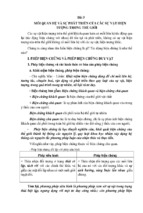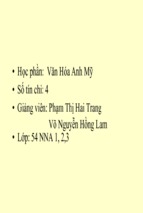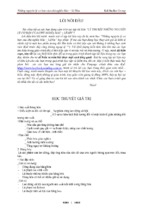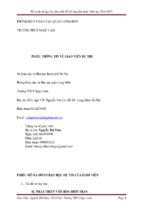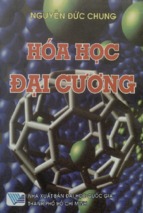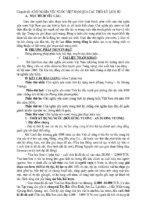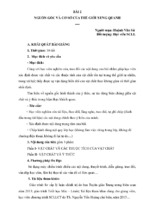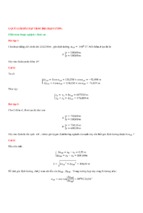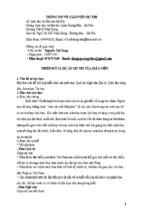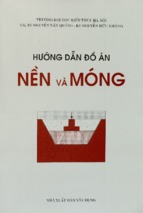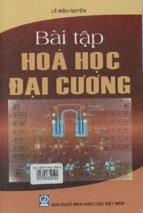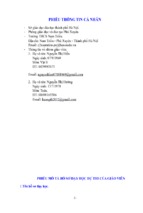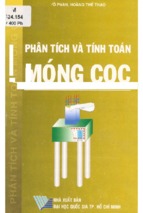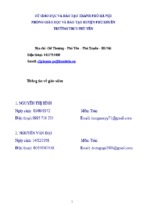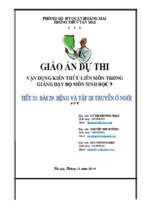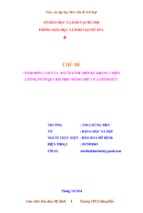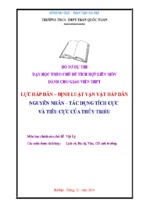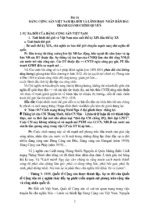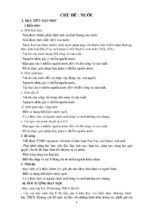Downloaded from ascelibrary.org by RMIT UNIVERSITY LIBRARY on 01/03/19. Copyright ASCE. For personal use only; all rights reserved.
International
Low Impact
Development
Conference China
2016
Applications in
Sponge City Construction
Proceedings of the International
Low Impact Development Conference China 2016
EDITED BY
Haifeng Jia, Ph.D., P.E., D.WRE; Shaw L. Yu, Ph.D.;
Robert Traver, Ph.D., P.E., D.WRE; Huapeng Qin, Ph.D.;
Junqi Li, Ph.D.; and Mike Clar, P.E., D.WRE
Beijing, China
June 26–29, 2016
Downloaded from ascelibrary.org by RMIT UNIVERSITY LIBRARY on 01/03/19. Copyright ASCE. For personal use only; all rights reserved.
INTERNATIONAL LOW IMPACT
DEVELOPMENT CONFERENCE CHINA
2016
LID APPLICATIONS IN SPONGE CITY PROJECTS
PROCEEDINGS OF THE INTERNATIONAL LOW IMPACT
DEVELOPMENT CONFERENCE CHINA 2016
June 26–29, 2016
Beijing, China
SPONSORED BY
Chinese Civil Engineering Society
Chinese Water Industry Society
Chinese Academy of Engineering—Division of Civil, Hydraulic, and
Architecture Engineering
Environmental and Water Resources Institute
of ASCE
EDITED BY
Haifeng Jia, Ph.D., P.E., D.WRE
Shaw L. Yu, Ph.D.
Robert Traver, Ph.D., P.E., D.WRE
Huapeng Qin, Ph.D.
Junqi Li, Ph.D.
Mike Clar, P.E., D.WRE
Published by the American Society of Civil Engineers
Downloaded from ascelibrary.org by RMIT UNIVERSITY LIBRARY on 01/03/19. Copyright ASCE. For personal use only; all rights reserved.
Published by American Society of Civil Engineers
1801 Alexander Bell Drive
Reston, Virginia, 20191-4382
www.asce.org/publications | ascelibrary.org
Any statements expressed in these materials are those of the individual authors and do not
necessarily represent the views of ASCE, which takes no responsibility for any statement
made herein. No reference made in this publication to any specific method, product, process,
or service constitutes or implies an endorsement, recommendation, or warranty thereof by
ASCE. The materials are for general information only and do not represent a standard of
ASCE, nor are they intended as a reference in purchase specifications, contracts, regulations,
statutes, or any other legal document. ASCE makes no representation or warranty of any
kind, whether express or implied, concerning the accuracy, completeness, suitability, or
utility of any information, apparatus, product, or process discussed in this publication, and
assumes no liability therefor. The information contained in these materials should not be used
without first securing competent advice with respect to its suitability for any general or
specific application. Anyone utilizing such information assumes all liability arising from such
use, including but not limited to infringement of any patent or patents.
ASCE and American Society of Civil Engineers—Registered in U.S. Patent and Trademark
Office.
Photocopies and permissions. Permission to photocopy or reproduce material from ASCE
publications can be requested by sending an e-mail to
[email protected] or by locating a
title in ASCE's Civil Engineering Database (http://cedb.asce.org) or ASCE Library
(http://ascelibrary.org) and using the “Permissions” link.
Errata: Errata, if any, can be found at https://doi.org/10.1061/9780784481042
Copyright © 2017 by the American Society of Civil Engineers.
All Rights Reserved.
ISBN 978-0-7844-8104-2 (PDF)
Manufactured in the United States of America.
Front cover: The editors would like to thank the Beijing Tsinghua Tongheng Urban
Planning & Design Institute for its permission for using the cover photo.
International Low Impact Development Conference China 2016
Preface
Downloaded from ascelibrary.org by RMIT UNIVERSITY LIBRARY on 01/03/19. Copyright ASCE. For personal use only; all rights reserved.
The 2016 International Low Impact Development (LID) Conference was successfully held
at the China National Conference Center in Beijing, China during June 26-29, 2016. The
conference brought together experts and scholars from more than 23 countries and regions
to Beijing, China. A total of nearly 800 papers were submitted, of which 576, through rounds
of peer reviews, were selected and presented at the conference. There were 6 topical tracks,
4 special sessions and 4 keynote presentations. The major theme of the conference was
theory and practice of LID and green infrastructure (GI) application, which provided timely
and valuable information for the implementation of the “Sponge City” projects, a major
urban water management initiative, in China.
The conference papers were reviewed by members of the program committee and selected
authors were invited to submit their papers for possible publication in the ASCE
Proceedings. Manuscripts submitted were reviewed by proceeding editors listed below:
Haifeng Jia, Tsinghua University
Shaw L. Yu, University of Virginia
Robert Traver, Villanova University
Huapeng Qin, Peking University Shenzhen Graduate School
Junqi Li, Beijing University of Civil Engineering and Architecture
Mike Clar, Ecosite Inc.
The papers approved for inclusion in the Proceedings are grouped into the following major
tracks:
LID and Urban Planning & Design
LID/GI Research & Development
Urban Water Infrastructure System Design & Optimization
LID/GI Practices – Case Studies and Recent Advances
Acknowledgements
We acknowledge the sponsorship and financial support provided for the conference. Efforts
by all the authors, editors and assistance by EWRI and the ASCE Publications are greatly
appreciated.
© ASCE
iii
International Low Impact Development Conference China 2016
Contents
Downloaded from ascelibrary.org by RMIT UNIVERSITY LIBRARY on 01/03/19. Copyright ASCE. For personal use only; all rights reserved.
Urban Hydrology and Water Systems
Temporal and Spatial Variations of Extreme Precipitation and Flood
Thresholds in Qinghe Basin in Beijing, China ............................................................................1
Li Lu, Xuebiao Pan, Lizhen Zhang, and Xingyao Pan
The Effects of Low Impact Development Practices on Urban Stormwater
Management .................................................................................................................................12
Na Li, Qian Yu, Jing Wang, and Xiaohe Du
The Impact of Focused Recharge with LID Devices on Groundwater
Dynamics and Water Quality under Natural Rainfall Conditions .........................................21
Zhonghua Jia, Qing Xu, Wan Luo, and Shuangcheng Tang
Assessment of Stormwater Management and Storage Capacity for
Urban Green Space in Shanghai City ........................................................................................27
Bingqin Yu, Shengquan Che, and Jiankang Guo
Index System of Urban Rainwater Collection and Utilization in
Beijing City under Low Impact Development...........................................................................37
Anping Shu, Xing Zhou, Donglian Kong, Lu Tian, and Li Huang
Verification of the Effectiveness of BMP Techniques in a Long Time
Period Using Trend Analysis ......................................................................................................45
Zijing Liu and Yuntao Guan
Application of LID Attribute Index Evaluation Method in the Design
of Urban Stormwater Control ....................................................................................................57
Jiangyun Li, Wang Sheng, Qing Chang, and Yi Zhou
Comparative Analysis of Different Evapotranspiration Estimation
Methods Used in a Raingarden in Auckland, New Zealand ....................................................66
Tingting Hao, Asaad Shamseldin, Keith Adams, and Bruce Melville
Concurrent Potential for Flooding Risk Reduction of Decentralized
Rainwater Management System .................................................................................................76
Donggeun Kwak, Minju Lee, Soyoung Baek, and Mooyoung Han
Urban Runoff Simulation and Analysis
Modeling of Streamflow in an Underdrain System of Vegetated
Dry Swales ....................................................................................................................................85
Sidian Chen, Huapeng Qin, and Shuxiao Li
© ASCE
iv
International Low Impact Development Conference China 2016
Stochastic Long Time Series Rainfall Generation Method ......................................................92
Yi Zhou, Yu Shang, Jiangyun Li, and Qiufeng Tang
Downloaded from ascelibrary.org by RMIT UNIVERSITY LIBRARY on 01/03/19. Copyright ASCE. For personal use only; all rights reserved.
Effects of Low Impact Development Practices on the Mitigation of
Nutrient Pollution in Deep Bay, China ....................................................................................100
Sidian Chen, Mingfeng Zheng, Huapeng Qin, and Xueran Li
Modeling of Bioretention Systems’ Hydrologic Performance: A
Case Study in Beijing .................................................................................................................108
Meishui Li, Xiaohua Yang, Lei Chen, and Zhenyao Shen
Estimating Water Quality Capture Volume for LID Designs
Using a Mechanical Wash-Off Model ......................................................................................118
Qi Zhang, Fang Yang, and Zhijie Zhao
Distribution Analysis for Non-Point Source Pollution Control
Programs Using Multivariate Statistical Analysis Methods ..................................................126
Zijing Liu and Yuntao Guan
Study on Spatial Characteristics and Load of Urban Non-Point
Source Pollution Based on Geostatistical Model .....................................................................137
Sheng Xie, Kai Yang, Yong Peng Lyu, Chen Zhang, Yue Che, and Lei Ding
Rainfall-Storage-Pump-Discharge (RSPD) Model for Sustainable
and Resilient Flood Mitigation .................................................................................................152
Duc Canh Nguyen and Moo Young Han
Runoff Characteristics on LID Combination Type in the New
Development Site Using XPSWMM .........................................................................................162
Donggeun Kwak, Hyunwoo Kim, and Mooyoung Han
Runoff LID Control Technology
Isolation and Characterization of a PYR-Degrading Bacterial
Consortium for Bioaugmentation in Bioretention Systems ...................................................172
Dongqi Wang, Zhangjie Yang, Jiaqi Shan, Enyu Liu, Guodong Chai, Chan Li,
Xiaohua Lin, Wen Dong, Huaien Li, and Jiake Li
Evaluation of the Effects of Low Impact Development on Base
Flow in an Urbanized Watershed Using HSPF .......................................................................179
Qi Zhang, Zhijie Zhao, and Huapeng Qin
Groundwater Replenishment Analysis of Rainfall Collected via
an Ecological Detention Facility ...............................................................................................186
Fengqing Guo, Yuntao Guan, and Tanaka Hiroaki
© ASCE
v
International Low Impact Development Conference China 2016
Downloaded from ascelibrary.org by RMIT UNIVERSITY LIBRARY on 01/03/19. Copyright ASCE. For personal use only; all rights reserved.
Reinvent of a New Public Toilet Wastewater Treatment System
Using Forward Osmosis as the Key Unit: A Resources Close-Loop
Model in Urban LID ..................................................................................................................194
Yangyu Xu, Lu Zhou, and Qibo Jia
LID-Based Ecological Planting Groove for Road Runoff Purification
Research ......................................................................................................................................204
Xuexin Liu, Xueping Chen, Shaoyong Lu, Xinzhu Xiong, Shuohan Gao,
and Yaping Kong
Green Building and Green Roofs
How to Construct Green Roofs on the Tops of Existing Buildings:
A Case Study in Shanghai .........................................................................................................214
Tianqing Luo, Yining Su, and Libin Chen
Behavior of Soil Moisture in a Retentive Green Roof System ...............................................223
Saerom Yoon, Juyoung Lee, and Mooyoung Han
Impact Study of Thermal Environment on Integration of Extensive
Green Roof Techniques in Northwestern Arid Regions of China .........................................231
Yajun Wang, Rajendra Prasad Singh, Dafang Fu, and Junyu Zhang
Sponge Cities and Landscapes
Traditional Pattern of Mountain-Water-City and Its Contemporary
Enlightenment: Changshou District of Chongqing as a Case................................................241
Lu Guo
Landscape-Scale Simulation Analysis of Waterlogging and Sponge
City Planning for a Central Urban Area in Fuzhou City, China ..........................................251
Shaoqing Dai, Jiajia Li, Shudi Zuo, Yin Ren, and Huixian Jiang
Adaptation to Water: A Study on Bamboo Landscape System with
Low Impact Development .........................................................................................................261
Renwu Wu, Jun Zheng, Yan Shi, Fan Yang, and Zhiyi Bao
A Balance of Landscape Architectural Planning and Design among
Antiterrorism Concern with Nature, Cultural, or Socio-Economic
Ecosystem Services.....................................................................................................................267
Kaitai Lin
Case Studies
Optimization Study of Urban Stormwater Runoff Control BMPs
Scheme Based on SUSTAIN ......................................................................................................278
Yifan Zeng, Xiaodong Long, Zimu Jia, Weihua Zeng, and Jianbin Shi
© ASCE
vi
International Low Impact Development Conference China 2016
Downloaded from ascelibrary.org by RMIT UNIVERSITY LIBRARY on 01/03/19. Copyright ASCE. For personal use only; all rights reserved.
Comparison of Stormwater Management in the Community Park
between China and Singapore: A Case Study of Hillside Eco Park
and Crescent and Pioneer Hall .................................................................................................289
Mo Wang, Dong Qing Zhang, Ya Wang, Jin Su, Jian Wen Dong,
and Soon Keat Tan
Effects of Land Use and Rainfall Characteristics on River Pollutions:
A Case Study of Xili Reservoir Watershed in Shenzhen, China ...........................................304
Lixun Zhang, Bo Zhao, and Yuntao Guan
Low Impact Stormwater Management Development at Rutgers
University ....................................................................................................................................318
Seth Richter, Christian Roche, and Qizhong Guo
Sponge City Construction and Management Strategies
Low Impact Thinking of the Spongy City Construction in Built-Up
Areas from the Perspective of Sustainable Urban Design .....................................................328
Xili Han, Wenqiang Zhao, Linus Zhang, and Peter Siostrom
Challenges and Future Improvements to China’s Sponge City
Construction ...............................................................................................................................339
Hong Wang, Xiaotao Cheng, Li Man, Na Li, Jing Wang, and Qian Yu
A CFD-Based Level Sensor Location Optimization Method for
Overflow Discharge Estimation in CSOs .................................................................................352
Hexiang Yan, Kangqian Zhao, Gislain Lipeme Kouyi, Tao Tao, Kunlun Xin,
and Shuping Li
Value and Rational Use of Landform Resources in Low Impact
Development ...............................................................................................................................363
Dehua Mao, Wen Liu, and Min Yang
The Application of Adaptive Design Strategies in Urban Green
Stormwater Infrastructure Development ................................................................................372
Wei Zhang, Jack Ahern, and Xiaoming Liu
Hydrologic Design and Economic Benefit Analysis of Rainwater
Harvesting Systems in Shanghai, China ..................................................................................381
Shouhong Zhang and Xueer Jing
A New Approach to Urban Water Environment Protection: Leasing
Mode and Its Risk Management of Urban Rivers and Lakes Pollution
Control Projects under Public-Private Partnership Model ...................................................390
Zhixuan Wu, Lu Zhou, Yi Zhou, and You Zhou
© ASCE
vii
International Low Impact Development Conference China 2016
Temporal and Spatial Variations of Extreme Precipitation and Flood Thresholds in Qinghe
Basin in Beijing, China
Li Lu1; Xuebiao Pan2; Lizhen Zhang3; and Xingyao Pan4
Downloaded from ascelibrary.org by RMIT UNIVERSITY LIBRARY on 01/03/19. Copyright ASCE. For personal use only; all rights reserved.
1
Agricultural Meteorological Dept., College of Resources and Environmental Sciences, China
Agriculture Univ., P.O. Box 100193, Yuanmingyuan Xi Rd. No. 2, Haidian District, Beijing;
Dept. of Beijing East-to-West Water Diversion Project, Beijing Water Authorities Bureau, P.O.
Box 100192, Qinghe Rd. No. 189, Haidian District, Beijing. E-mail:
[email protected]
2
Agricultural Meteorological Dept., College of Resources and Environmental Sciences, China
Agriculture Univ., P.O. Box 100193, Yuanmingyuan Xi Rd. No. 2, Haidian District, Beijing
(corresponding author). E-mail:
[email protected]
3
Agricultural Meteorological Dept., College of Resources and Environmental Sciences, China
Agriculture Univ., P.O. Box 100193, Yuanmingyuan Xi Rd. No. 2, Haidian District, Beijing. Email:
[email protected]
4
Beijing Water Sciences and Technology Institute, P.O. Box10004, Chegongzhuang Xi Rd. No.
21, Haidian District, Beijing. E-mail:
[email protected]
ABSTRACT
Extreme weather frequently causes torrential rains and flooding in modern cities, e.g.,
Beijing, which are much sensitive and fragile to flooding disasters because of high population
density. In this study, we aimed to quantify the temporal and spatial distribution of extreme
precipitation in Qinghe Basin in Beijing and to develop optimal flood management thresholds by
using precipitation records from 1986 to 2014 in two sites of the region. The time that maximum
precipitation occurs in a year differed temporally and spatially and mainly concentrated in July
and August. Extreme precipitation amount covered 41.7% of total precipitation in a month
during flood season. Rain days of rainstorms were on average 1.7 d and 87% of them
concentrated in July and August and were more in upstream than that in downstream.
Precipitation intensity (SDII) during flood season was on average 11.7 mm d1 and highest (15.1
mm d1) in July. SDII during critical flood control period increased in upstream during recent 30
years and implied a high flood risk in the future. The spatial distribution of precipitation intensity
was significantly different. Our results at basin level would help city authorities designing
optimal flood control constructions, drainage facilities, and warning systems.
KEY WORDS: climate variation; flood control; precipitation intensity; rain events; urban
area
INTRODUCTION
Meteorological and secondary disasters happened frequently due to the extreme weather
under climate change in the world especially during 21 century. Under climate change, the
maximum of total precipitation and extreme rain events from 1950 to 2014 occurred in 1990s
and 2000s, and the extreme rain events would continuously increase according to the report of
Intergovernmental Panel on Climate Change (IPCC) (2014). Since meteorological disasters
cause significant social and economic losses, governments, civil societies, organizations and the
public therefore pay great concern to the managements of the disasters for the alleviation of the
negative influences of climate changes.
Extreme weathers frequently cause torrential rains and flooding in modern cities, e.g. Beijing
© ASCE
1
Downloaded from ascelibrary.org by RMIT UNIVERSITY LIBRARY on 01/03/19. Copyright ASCE. For personal use only; all rights reserved.
International Low Impact Development Conference China 2016
and Shanghai, which are more sensitive and fragile to flooding disasters because of high
population density. The average annual cost of natural disasters was 200 to 400 billion Yuans
from 1949 to 1989 and gradually increased due to the climate changes. The safety of big cities,
including managements, lives and properties, is greatly threatened by seeping in streets,
rainwater intrusion into underground facilities and other damages caused by extreme
precipitation events. “Metropolis Disease” due to extreme precipitations were frequently
reported by public media. For example, a heavy rain of 170 mm in one day, with a maximum
precipitation of 541 mm in Hebeizhen in Fangshan District, attacked Beijing on July 21, 2012,
which broke a historical record of single rain station in Beijing. Nearly 600 million m3 rainwater
concentrated in a 2000 km2 area in Fangshan District during 10 hours, which equaled that the
Kunming Lake in Summer Palace was poured down once every 3 minutes. The highest rainstorm
warning grade with “Orange Degree” and “Level II” of Flood Control Emergency were
announced. The direct economic losses were as high as 11.8 billion Yuan, and 119.28 million
populations were greatly affected. Total 9.48 million people were transferred to safe regions in
emergency, and 79 people were died during this terrible event. More than 10 thousands of houses
collapsed, 940 enterprises were discontinued, and 361 kilometers embankments were damaged.
The huge losses from this extreme precipitation event were partially due to the limitation
knowledge on the relationship between extreme rain and flood occurrence in a big city.
Temporal and spatial distribution of precipitation intensity in relation to the land use types and
population density would significantly affect the alarm threshold. However, such important
studies are lagged.
Average annual rainstorm days in China showed a slight but not significant increasing trend
in the past half century (Zhi et al., 2006; Min and Qian, 2008; Feng et al., 2008; Zou et al., 2009;
Chen et al., 2010). The frequency and intensity of extreme precipitation over total rainfall events
increased in most of China, while the rainfall days tended to be decreasing, and annual rainstorm
days slightly increased with high differences in temporal and spatial distribution (Zhai et al.,
2005; Wang and Zhai, 2008). Heavy rainfall in summer reduced in the north of China (Wang and
Yan, 2009). The frequency and intensity of extreme precipitation events decreased in North
China (Alexander et al., 2006; Wang et al., 2012). The frequency of precipitations during 1954 to
2006 reduced in North China; however, that of heavy rain did not too (Tu et al., 2010). The
extreme precipitation intensity and frequency of big cities in north of China were increased more
than in surrounding agricultural areas (Wang and Zhai, 2009). Although the extreme
precipitation amount, days and intensity in Beijing showed a downward trend from 1981 to 2010
(You et al. (2009), the highest precipitation intensity occurred in 2012. That implies increased
variations of precipitations in Beijing, thus, it is necessary to explore the temporal and spatial
variations of precipitations in relation to flood control based on the capability of flood discharges
at a basin level.
The objectives of this study therefore were to (a) quantify the temporal and spatial
distribution of extreme precipitations with frequency, amount and intensity in the basin of
Qinghe River in north of Beijing city, where is one of four rivers in the capital urban center with
a drainage area of 175 km2, a length of 28.7 km, an elevation range from 24.4 m to 500.3 m, and
a stream length of 23.7 km; and (b) develop an extreme precipitation threshold (index) for the
flood control of Beijing city in relation to the real basin situation, in which the hydraulic
structures and embankment of Qinghe River are 20 years of flood recurrence period. Considering
natural and social factors, the study would help to design an optimal construction of Sponge
Cities and provide scientific support to emergency warning and response activities.
© ASCE
2
International Low Impact Development Conference China 2016
3
MATERIALS AND METHODS
Downloaded from ascelibrary.org by RMIT UNIVERSITY LIBRARY on 01/03/19. Copyright ASCE. For personal use only; all rights reserved.
Study sites
The study sites are Qinghe (40o01'N, 116o20'E) and Yangfang (40o02'N, 116o24'E) located in
north of Beijing city (Fig. 1), where are main regions for rain water collection in Qinghe basin.
Ten flood discharge gates are distributed along Qinghe river, i.e. Anhe gate, Xiaojiahe gate,
Shucun gate, Jingbao gate, Qinghe gate, Xiaqinghe gate, Yangfang gate, Waihuan gate,
Shenjiafen gate and Shaziying gate (Fig. 1). The basin lies in semi-humid continental monsoon
climate, affected by the high-pressure Mongolia with prevailing northerly winds in winter, and
by the continental thermal low-pressure system with prevailing southerly winds in summer.
Qinghe site is located at upstream of Qinghe basin in the front terrain of Jundu mountain, and the
climate is characterized as a strong air convection current, which often causes rainstorms.
Yangfang site is located at downstream of Qinghe basin and affected by urban heat island effect,
by which short and partly rainstorm often occurs. The two sites therefore could well present the
precipitation situation of studied basin.
Shaziying gate
Shenjiafen gate
Yangfang gate
Waihuan gate
Qinghe gate
Xiaqinghe gate
Shucun gate
Jingbao gate
Anhe gate
Xiaojiahe gate
Beijing
Figure 1. Locations of studied sites (red color crosses) and water discharge gates (blue filled
circles) for controlling flood of Beijing.
Data source
The precipitation data of studied sites of Qinghe and Yangfang was from local
meteorological and hydrological stations. Data was recorded from 1986 to 2014. During 1986 to
2004, the precipitation data was measured by a 0.5 mm resolution manual rain gauge. During
2005 to 2014, the data was measured by a 0.1 mm resolution automatic rain gauge. All data was
manually re-checked by local hydraulic station to ensure the accuracy.
Data analysis
Extreme weather events are rare weather events in specific areas and time (Solomon et al.,
2007). Extreme weather event is defined as a weather event of a certain region when it seriously
deviates from its average. Since “abnormal weather” is relative meaning that is not same for
different regions and seasons, World Meteorological Organization Commission for Climatology
(CCI/ WMO) recommends to divide climate extremes index into two categories, one is depended
© ASCE
4
on absolute physical boundaries and another is relative extreme index, which extreme events
have statistical probability of extreme low or high values, i.e. less than 10 percentile or greater
than 90 percentile in accumulative distribution function (Wang and Wang, 2007).
Seasonal distribution of precipitations in Beijing is uneven, especially in the studied region
where the precipitations during flood season (June to September) account for 64% of the total
annual precipitations and most daily precipitations in winter (from November to January) are
zero. We therefore only focused the period of flood season (1 June to 30 September). All
calculations were done only during this period. The absolute values for categorizing extreme
precipitations were used in this study.
In order to classify precipitations into categories, i.e. middle rain, heavy rain and rainstorm,
we used absolute thresholds which are commonly used in Beijing region. We categorized a
precipitation greater than 10 mm as a middle rain, 25 mm as a heavy rain and 50 mm as a
rainstorm. The days of each rain category were calculated accordingly.
SDII defined as index of precipitation intensity is the total precipitation amount divided by
rain days.
300
Occurrence time of highest precipitation (d)
Downloaded from ascelibrary.org by RMIT UNIVERSITY LIBRARY on 01/03/19. Copyright ASCE. For personal use only; all rights reserved.
International Low Impact Development Conference China 2016
280
260
September
240
August
220
200
July
180
June
160
y = 0.6192x - 1030
R2 = 0.0592 (QH)
140
Qinghe (QH)
120
Yangfang (YF)
100
1985
1990
1995
y = 0.4833x - 761.05
R2 = 0.0187 (YF)
2000
2005
2010
2015
Years
Figure 2. Distribution of occurrence time (Calendar days) of maximum precipitation per
year from 1986 to 2014 in Qinghe and Yangfang, Beijing. Color filled areas indicate flood
season and months.
© ASCE
International Low Impact Development Conference China 2016
Downloaded from ascelibrary.org by RMIT UNIVERSITY LIBRARY on 01/03/19. Copyright ASCE. For personal use only; all rights reserved.
Ratio of extreme precipitation
1
a June
5
b July
0.8
0.6
0.4
0.2
y = -0.0022x + 4.84
R2 = 0.0203 (QH)
y = -0.0026x + 5.6517
R2 = 0.0243 (YF)
y = 0.0051x - 9.7404
R2 = 0.0859 (QH)
y = 0.0062x - 12.08
R2 = 0.0962 (YF)
0
1
Ratio of extreme precipitation
c August
d September
0.8
0.6
0.4
0.2
y = 0.0046x - 8.771
R2 = 0.0715 (QH)
y = 0.0016x - 2.7767
R2 = 0.0112 (YF)
y = 0.0042x - 8.0141
R2 = 0.0426 (QH)
y = 0.0046x - 8.7884
R2 = 0.0505(YF)
0
1985
0.5
Ratio of extreme precipitation
e Flood period
1990
1995
2000
2005
2010
2015
Years
Qinghe (QH)
0.4
Yangfang (YF)
0.3
0.2
0.1
y = 0.0014x - 2.631
R2 = 0.0421 (QH)
0
1985
1990
1995
y = 0.0007x - 1.1573
R2 = 0.0045 (YF)
2000
2005
2010
2015
Years
Figure 3. Trends of the ratio of extreme precipitation amount over total precipitation
during a period from 1986 to 2014 in Qinghe and Yangfang, Beijing
RESULTS
Extreme precipitations
The time that maximum precipitation occurs in a year was distributed almost all within June
to September (flood season), except for an exclusion of 1997 in Yangfang (Fig. 2). The highest
frequency of the occurring time was in July, while that rarely distributed in June and September.
© ASCE
Downloaded from ascelibrary.org by RMIT UNIVERSITY LIBRARY on 01/03/19. Copyright ASCE. For personal use only; all rights reserved.
International Low Impact Development Conference China 2016
6
Comparing to a concentrated distribution of occurring times of maximum precipitation events in
Qinghe, the occurring times in June and September in Yangfang were much more, where there
were also not much maximum precipitations in these two months.
The ratios of extreme precipitation over total precipitation in June for both Qinghe and
Yangfang were slightly decreased from 1986 to 2014 (Fig. 3a), while that in July, August and
September showed increasing trends (Fig. 3b,c,d). In June, the extreme precipitations and their
variations before 1991 were much higher, comparing to a stable trend after 1991. However, the
variations of the ratio of extreme precipitation over total amount of rainfall in July during 2000
to 2014 were much higher than before 1994. That indicates an increased risk of flood in Beijing
in July.
Days of extreme precipitations
Rain days of middle precipitations (R10 mm) during flood season averaged from 1986 to
2014 were 13.1 d and 16.7% more in 1980s than the average of 1990s and 2000s in Qinghe,
while that were 13.8 d and 22.7% more in 1980s. The middle rain events mostly occurred in July
and August. Rain days of heavy precipitations (R25 mm) during flood season averaged from
1986 to 2014 were 5.2 d in Qinghe and 5.9 d in Yangfang. The 36-44% heavy rain events
concentrated in July in both sites, while it rarely happened in September. Rain days of rainstorm
(R50 mm) during flood season on average of 1986 to 2014 were 1.8 d in Qinghe and 1.6 d in
Yangfang (Table 1). Events of rainstorms concentrated in July and August with a proportion of
80% over flood season for both sites, which indicated a critical period to control the flood in
Beijing city.
Table 1 Rain days of threshold precipitation events (d) during flood season (June to
September) from 1986 to 2014 in Qinghe and Yangfang, Beijing
Indexa
R10 mm
Period
R50 mm
Yangfang
1980s
1990s
2000s
Average
June
1.8
1.9
2.7
July
5.0
5.8
August
6.0
September
2.2
b
1980s
1990s
2000s
Average
2.3
3.8
2.7
3.6
3.3
4.7
5.1
5.0
5.5
4.0
4.7
3.6
3.7
4.0
5.0
3.9
3.5
3.8
1.7
1.6
1.7
2.7
1.9
1.8
2.0
15.0
13.0
12.7
13.1
16.5
14.0
12.9
13.8
June
0.8
0.8
0.7
0.7
2.3
1.7
1.7
1.8
July
1.5
3.0
2.1
2.3
2.0
2.9
1.5
2.1
August
2.2
1.6
1.6
1.7
2.0
1.9
1.5
1.7
September
0.5
0.5
0.5
0.5
0.0
0.6
0.3
0.3
Flood season
5.0
5.9
4.9
5.2
6.3
7.1
5.0
5.9
June
0.3
0.5
0.1
0.3
0.3
0.3
0.1
0.2
July
0.2
1.4
0.8
0.9
0.2
1.1
0.5
0.7
August
0.5
0.6
0.5
0.5
1.5
0.7
0.3
0.6
September
0.0
0.0
0.1
0.1
0.0
0.1
0.1
0.1
Flood season
R25 mm
Qinghe
Flood season
1.0
2.5
1.5
1.8
2.0
2.2
1.0
1.6
Index of R10 mm, R25 mm and R50 mm indicates rain days of middle (>10 mm), heavy (>25 mm) and rainstorm
(>50 mm) precipitation events, respectively.
b
Average indicates the data is averaged from 1986 to 2014.
a
© ASCE
International Low Impact Development Conference China 2016
7
From 1986 to 2014, R10 mm greatly decreased in two sites, especially in Yangfang (Fig. 4b).
R50 mm showed only a slight decrease in both sites. R25 mm had a similar decreasing trend.
The yearly variations of R50 mm were smaller than that of R10 mm and R25 mm (Fig. 4).
Days of extreme precipitation (d)
Downloaded from ascelibrary.org by RMIT UNIVERSITY LIBRARY on 01/03/19. Copyright ASCE. For personal use only; all rights reserved.
25
20
a Qinghe
b Yangfang
y = -0.0507x + 114.62
R2 = 0.0178 (R10mm)
y = -0.0128x + 27.374
R2 = 0.0058 (R50mm)
y = -0.164x + 341.84
R2 = 0.1487 (R10mm)
y = -0.0507x + 103.03
R2 = 0.1063 (R50mm)
y = -0.0261x + 57.458
R2 = 0.0072 (R25mm)
y = -0.0901x + 186.19
R2 = 0.0814 (R25mm)
15
10
5
0
1985
1995
2015 1985
2005
1995
Years
R10mm
R25mm
Years
2005
2015
R50mm
Figure. 4 Trends of rain days of threshold precipitation events (d) during flood season
(June to September) from 1986 to 2014 in Qinghe (a) and Yangfang (b), Beijing. R10 mm,
R25 mm and R50 mm indicate rain days of middle (>10 mm), heavy (>25 mm) and
rainstorm (>50 mm) precipitation events, respectively
Precipitation intensity
SDII index, defined as an averaged precipitation intensity (mm d1) calculated by the ratio of
total precipitation amount during a period divided by rain days, was similar in two sites on
average from 1986 to 2014 during flood period, i.e. 11.8 mm d1 in Qinghe and 11.5 mm d1 in
Yangfang (Table 2). The highest SDII occurred in July with a value of 14.9 mm d1 in Qinghe
and 15.2 mm d1 in Yangfang. SDIIs in June and September were low ranged from 7.1 mm d1 to
8.6 mm d1 on average from 1986 to 2014. The highest SDII occurred in July of 1990s ranged
from 16.5 mm d1 to 18.1 mm d1 in two sites.
Table 2 Monthly averaged precipitation intensity (SDII, mm d1) from 1986 to 2014 and
during three decades in Qinghe and Yangfang, Beijing
Site
Qinghe
Yangfang
Period
Flood season
June
July
August
September
1980s
11.7
11.4
9.6
16.6
7.6
1990s
12.1
8.1
16.5
11.8
6.1
2000s
11.6
8.1
15.2
13.5
7.7
1986-2014
11.8
8.6
14.9
13.4
7.1
1980s
12.0
12.0
11.3
16.2
6.7
1990s
12.7
8.4
18.1
12.4
7.4
2000s
10.6
7.8
14.2
11.9
7.6
1986-2014
11.5
8.6
15.2
12.6
7.4
SDII is the total precipitation per month or during flood season divided by rain (wet) days during the period.
© ASCE
International Low Impact Development Conference China 2016
8
From 1986 to 2014, SDII showed a slight but not significant decreasing trend during flood
period in Yangfan, however SDII in Qinghe during flood period increased (Fig. 5). While SDIIs
in June and August slightly decreased in two sites, during July, which is the critical flood control
period, and September, these trends were increasing especially in Qinghe (Fig. 5b).
40
Downloaded from ascelibrary.org by RMIT UNIVERSITY LIBRARY on 01/03/19. Copyright ASCE. For personal use only; all rights reserved.
a June
y = 0.0062x - 12.08
R2 = 0.0962 (YF)
b July
35
SDII index (mm d -1)
30
y = -0.0022x + 4.84
R2 = 0.0203 (QH)
25
20
y = -0.0026x + 5.6517
R2 = 0.0243 (YF)
15
10
5
y = 0.0051x - 9.7404
R2 = 0.0859 (QH)
0
40
c August
d September
SDII index (mm d -1)
35
30
25
y = 0.0016x - 2.7767
R2 = 0.0112 (YF)
y = 0.0046x - 8.771
R2 = 0.0715 (QH)
y = 0.0046x - 8.7884
R2 = 0.0505(YF)
20
y = 0.0042x - 8.0141
R2 = 0.0426 (QH)
15
10
5
0
1985
40
35
e Flood period
SDII index (mm d -1)
2000
2005
2010
2015
Qinghe (QH)
y = 0.0007x - 1.1573
R2 = 0.0045 (YF)
25
1995
Years
y = 0.0014x - 2.631
R2 = 0.0421 (QH)
30
1990
Yangfang (YF)
20
15
10
5
0
1985
1990
1995
2000
2005
2010
2015
Years
Figure. 5 Trends of precipitation intensity (SDII) during flood period from 1986 to 2014 in
Qinghe and Yangfang, Beijing
© ASCE
International Low Impact Development Conference China 2016
Downloaded from ascelibrary.org by RMIT UNIVERSITY LIBRARY on 01/03/19. Copyright ASCE. For personal use only; all rights reserved.
CONCLUSIONS AND DISCUSSION
The time that highest precipitation occurs in a year differed temporally and spatially and
mainly concentrated in July and August. Extreme precipitation amount covered, on average for
sites and months, 41.7% of total precipitation in a month during flood season. Extreme
precipitation amount in July, August and September in Beijing increased from 1986 to 2014,
especially in July, which was consistent with Zhang et al. (2008) and You et al. (2009). That
indicates the flood risk in Beijing would increase due to the climate change or probably fast
urbanization.
Rain days of heavy precipitations during flood season on average were 5.6 d and 40% of
them concentrated in July. Rain days of rainstorm, as critical events for flood control, were on
average 1.7 d and 80% of them distributed in July and August. However, rainstorm events
showed the decreasing trends from 1986 to 2014. Rain days of rainstorms were more in upstream
of Qinghe basin than that in downstream, which were probably caused by the mountain effects.
The results were consistent with previous studies (Alexander et al., 2006; You et al., 2009; Wang
et al., 2012).
Precipitation intensity (SDII) during flood season was on average 11.7 mm d1 and highest
(15.1 mm d1) in July. The spatial distribution of precipitation intensity was significantly
different. SDII during critical flood control period (July) slightly but not significantly decreased
in downstream of Qinghe basin (Yangfan site), however, increased in upstream (Qinghe site)
during recent 30 years. It implies the flood risk of upstream would increase and discharging
pressure of whole basin further increase.
In Beijing city, the 5% extreme precipitation covers 30-38% of total amount of precipitation
and critical flood control period is from 20 July to 10 August (You et al., 2009). However, our
study showed the extreme precipitation proportioned 38-47% of total precipitation during flood
season in Qinghe basin, which was 25% higher than the average of total Beijing. The critical
flood control period based on the frequency and intensity of precipitation events was from 20
June to 16 August in Qinghe basin, which was 36 d longer than that in total Beijing.
The temporal and spatial distribution of extreme precipitation in terms of occurrence time,
days and the intensity in Beijing at a basin level would help city authorities designing an optimal
flood control constructions, drainage facilities and warning systems. Due to the increasing trend
of extreme precipitation in Qinghe basin, the standards of flood prevention and pipe drainage
adapted to the sponge city might be necessarily researched. In this study, we only focused on the
analysis of climate variation and trends, however, for a better control of flood in a huge city (e.g.
Beijing), the studies in relation to the land use changes due to city expansion, vegetation, river
flow and discharge areas should be considered to quantitatively clarify the relationship between
the rainfall and flood resources, inflow rate of a river and flood detention in outer and inner of
city.
ACKNOWLEDGEMENTS
The study was supported by National Nature Science Fund (NSFC) Project (41271053,
41475104).
REFERENCES
Alexander, L.V., Zhang, X., Peterson, T.C., Klein Tank, A.M.G., Haylock, M., Collins, D.,
Trewin, B., Rahimzadeh, F., Tagipour, A., Rupa Kumar, K., Revadekar, J., Griffiths, G.,
© ASCE
9
Downloaded from ascelibrary.org by RMIT UNIVERSITY LIBRARY on 01/03/19. Copyright ASCE. For personal use only; all rights reserved.
International Low Impact Development Conference China 2016
Vincent, L., Stephenson, D.B., Burn, J., Aguilar, E., Brunet, M., Taylor, M., New, M., Zhai,
P., Rusticucci, M. and Vazquez-Aguirre, J.L. (2006). “Global observed changes in daily
climate extremes of temperature and precipitation.” Journal of Geophysical research, 111,
D05109, doi: 10. 1029/2005JD006290.
Chen, J. and Liu, L. (2011). “Characteristics of urban rainstorm and its disaster cause over
Beijing in flood season of 2011. ” Torrential Rain and Disasters, 30(3), 282–287.
Chen, X., Conway, D., Chen, X.J. and Zheng, G. (2008). “Trends of extreme precipitation events
in Ningxia during 1961–2005.” Advances in Climate Change Research, 4(3), 156–160.
Chen, Y., Chen, X. and Ren, G. (2010). “Variation of extreme precipitation over large river
basins in China.” Advances in Climate Change Research, 6(4), 265–269.
Cunderlik, J.M. and Simonovic, S.P. (2007). “Inverse flood risk modelling under changing
climatic conditions.” Hydrological Processes, 21, 563–577.
Feng, G., Gong, Z., Zhi, R. and Zhang, D. (2008). “Analysis of precipitation characteristics of
South and North China based on the power-law tail exponents.” Chinese Physics B , 17 (7),
2745–2752.
Gong, D. and Han, H. (2004). “Extreme climate events in northern China over the last 50 years.”
Acta Geographica Sinica, 59(2), 230–238.
Han, S., Chen, X. and Li, N. (2009). “Introduction and experience of Swiss National Disaster
Management Committee: from disaster protection to risk managements.” China Flood &
Drought Management, 2, 75–78.
Hu, M. and Lu, C. (1981). China historical floods. Cathay Bookshop Publishing House, Beijing.
IPCC, (2014). Climate change 2014: impact, adaptation and vulnerability. Cambridge
University Press, Cambridge, UK, http://www.ipcc.ch/report/ar5/w92/.
Min, S. and Qian, Y. (2008). Trends in all kinds of precipitation events in China over the past 40
years. Acta Scientiarum Naturalium Universitatis Sunyatseni, 47(3), 105–111.
Prudhomme, C., Jakob, D. and Svensson, C. (2003). “Uncertainty and climate change impact on
the flood regime of small UK catchment.” Journal of Hydrology, 277, 1–23.
Qian, W., Fu, J. and Yan, Z. (2007). “Decrease of light rain events in summer associated with a
warming environment in China during 1961–2005.” Geophysical Research Letter, 34,
L11705, doi: 1011029/2007GL029631.
Ren, G.,Feng G. and Yan, Z. (2010). “Progresses in observation studies of climate extremes
and changes in mainland China EJ3.” Climatic and Environmental Research, 15 (4), 337–
353.
Solomon, S., Qin, D., Manning, M., Chen, Z., Marquis, M., Averyt, K.B., Tignor, M. and Miller,
H.L. (2007). Contribution of working group I to the fourth assessment report of the
intergovernmental panel on climate change. Cambridge University Press, Cambridge, United
Kingdom and New York, NY, USA, 996 pp.
Southam, C.F., Mills, B.N., Moulton, R.J., Brown, D.W. and Mills, B.N. (1999). “The potential
impact of climate change in Ontario's Grand River basin: water supply and demand issues.”
Canadian Water Resources Journal, 1999, 24(4), 307–330.
Sun, F., Yang, S. and Ren, G. (2007). “Decade variations of precipitation event frequency,
intensity and duration in the northeast China.” Journal of Applied Meteorological Science,
18(5), 610–618.
Tu, K., Yan, Z. and Dong, W. (2010). “Climatic jumps in precipitation and extremes in drying
North China during 1 954–2006.” Journal of the Meteorological Society of Japan, 88(1), 29–
42.
© ASCE
10
Downloaded from ascelibrary.org by RMIT UNIVERSITY LIBRARY on 01/03/19. Copyright ASCE. For personal use only; all rights reserved.
International Low Impact Development Conference China 2016
Wang, C. and Zhai, P. (2009). “Changes of precipitation extremes in China’s large cities.”
Climatic and Environmental Research, 14(5), 553–560.
Wang, J., Jiang, D. and Zhang, Y. (2012). “Analysis on spatial and temporal variation of extreme
climate events in north China.” Chinese Journal of Agrometeorology, 22(2), 166–173.
Wang, W. and Wang, X. (2008). “Analysis about extreme weather events and their
endangerment of city in 2007.” Meteorological Monthly, 34(4), 16–21.
Wang, X. and Zhai, P. (2008). “Changes in China’s precipitation in various categories during
1957–2004.” Journal of Tropical Meteorology, 24(5), 577–583.
Wang, Y. and Yan, Z. (2009). “Trends in seasonal total and extreme precipitation over China
during 1961-2007.” Atmospheric and Ocean Science Letters, 2 (3), 165–171.
Yan, Z. and Yang, C. (2000). “Climate change of extremes in China during recent decades.”
Climate and Environmental Research, 5(3), 267–238.
You, H., Liu, W. and Ren, G. (2014). “Variation Characteristics of Precipitation Extremes in
Beijing during 1981–2010.” Climatic and Environmental Research, 19(1), 69–77.
Zhai, P., Wang, C. and Li, W. (2007). “A review on study of change in precipitation extremes.”
Advances in Climate Change Research, 3(3), 144–148.
Zhai, P., Zhang, X., Wan, H. and Pan, X. (2005). “Trends in total precipitation and frequency of
daily precipitation extremes over China.” Journal of Climate, 18, 1096–1108.
Zhang, A., Gao, X. and Ren, G. (2008). “Characteristic of extreme precipitation events change in
central north China in recent 45 years.” Arid Meteorology, 26(4), 46–50.
Zhang, W. and Wan, S. (2008). “Detection and attribution of abrupt climate changes in the last
one hundred years.” Chinese Physics B, 17(6), 2311–2316.
Zhi, R., Gong, Z., Wang D. and Feng, G. (2006). “Analysis of the spatio-temporal of China
based on the characteristics of precipitation power-law exponent.” Acta Physica Sinica,
55(11), 6185–6191.
Zou, Y., Yang, X., Sun, X., Tang, J., Fang, J. and Liao, Y. (2009). “Seasonal difference of the
spatio-temporal variation of the number of the extreme precipitation processes in China.”
Journal of Nanjing University (Natural Sciences), 45(1), 98–109.
© ASCE
11
International Low Impact Development Conference China 2016
The Effects of Low Impact Development Practices on Urban Stormwater Management
Na Li, Ph.D.1; Qian Yu, Ph.D.2; Jing Wang, Ph.D.3; and Xiaohe Du4
Downloaded from ascelibrary.org by RMIT UNIVERSITY LIBRARY on 01/03/19. Copyright ASCE. For personal use only; all rights reserved.
1
State Key Laboratory of Simulation and Regulation of Water Cycle in River Basin, China
Institute of Water Resources and Hydropower Research, Beijing 100038, People’s Republic of
China; Research Center on Flood and Drought Disaster Reduction of the Ministry of Water
Resources, China Institute of Water Resources and Hydropower Research, Beijing 100038,
People’s Republic of China. E-mail:
[email protected]
2
State Key Laboratory of Simulation and Regulation of Water Cycle in River Basin, China
Institute of Water Resources and Hydropower Research, Beijing 100038, People’s Republic of
China; Research Center on Flood and Drought Disaster Reduction of the Ministry of Water
Resources, China Institute of Water Resources and Hydropower Research, Beijing 100038,
People’s Republic of China (corresponding author). E-mail:
[email protected]
3
State Key Laboratory of Simulation and Regulation of Water Cycle in River Basin, China
Institute of Water Resources and Hydropower Research, Beijing 100038, People’s Republic of
China; Research Center on Flood and Drought Disaster Reduction of the Ministry of Water
Resources, China Institute of Water Resources and Hydropower Research, Beijing 100038,
People’s Republic of China. E-mail:
[email protected]
4
State Key Laboratory of Simulation and Regulation of Water Cycle in River Basin, China
Institute of Water Resources and Hydropower Research, Beijing 100038, People’s Republic of
China; Research Center on Flood and Drought Disaster Reduction of the Ministry of Water
Resources, China Institute of Water Resources and Hydropower Research, Beijing 100038,
People’s Republic of China. E-mail:
[email protected]
ABSTRACT
Low impact development (LID), which aims at either infiltrating, evapotranspiring or storing
water at the source, plays an important role in managing urban rainwater. This paper summarizes
the effects of four individual LIDs (i.e., bioretention, green roof, porous pavement, and grass
swales) and several combinations of those LID practices on rainfall-runoff management. The
survey shows that both individual and combined LIDs are effective in controlling small and
medium rainfalls, and the performances are less obvious with increases of the rainfall depths.
Hence, the individual or combined LIDs applied with noticeable effects on low or moderate
rainfalls might not be useful for heavy rain events which would probably cause urban floods in
cities in China. Cities located in different regions show big differences in rainfall characteristics.
Rainfall intensity is an even more important factor than rainfall depth that influences
performances of LID practices. In the future, more studies should be directed to the effects of
LID measures on large storm runoff managements under different rainfall intensity-durationfrequency (IDF), which would be helpful to select suitable LID practices for cities in China.
INTRODUCTION
During the last decades, urbanization has almost swept across China. The population growth,
urban density changes, and land cover changes accompany with urbanizations and urban
developments. The traditional developments leading to land cover changes will raise the high
proportions of imperviousness. In addition, traditional developments will also result in increased
surface runoff volume, diminished infiltration and decreased baseflow in consequence
© ASCE
12

